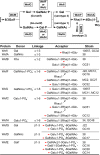Molecular and antigenic characterization of a Streptococcus oralis coaggregation receptor polysaccharide by carbohydrate engineering in Streptococcus gordonii
- PMID: 18303023
- PMCID: PMC2335359
- DOI: 10.1074/jbc.M801412200
Molecular and antigenic characterization of a Streptococcus oralis coaggregation receptor polysaccharide by carbohydrate engineering in Streptococcus gordonii
Abstract
The coaggregation receptor polysaccharides (RPS) of Streptococcus oralis and related species are recognized by lectin-like adhesins on other members of the oral biofilm community and by RPS-specific antibodies. The former interactions involve beta-GalNAc or beta-Gal containing host-like motifs in the oligosaccharide repeating units of these polysaccharides, whereas the latter involves features of these molecules that are immunogenic. In the present investigation, the molecular and corresponding structural basis for the serotype specificity of S. oralis ATCC 10557 RPS was determined by engineering the production of this polysaccharide in transformable Streptococcus gordonii 38. This involved the systematic replacement of genes in the rps cluster of strain 38 with different but related genes from S. oralis 10557 and structural characterization of the resulting polysaccharides. The results identify four unique genes in the rps cluster of strain 10557. These include wefI for an alpha-Gal transferase, wefJ for a GalNAc-1-phosphotransferase that has a unique acceptor specificity, wefK for an acetyl transferase that acts at two positions in the hexasaccharide repeating unit, and a novel wzy associated with the beta1-3 linkage between these units. The serotype specificity of engineered polysaccharides correlated with the wefI-dependent presence of alpha-Gal in these molecules rather than with partial O-acetylation or with the linkage between repeating units. The findings illustrate a direct approach for defining the molecular basis of polysaccharide structure and antigenicity.
Figures






References
Publication types
MeSH terms
Substances
Grants and funding
LinkOut - more resources
Full Text Sources
Molecular Biology Databases

